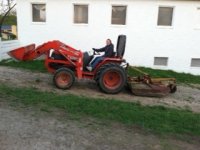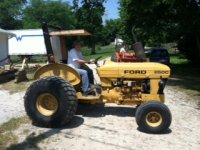Learning to Farm
Silver Member
- Joined
- May 24, 2011
- Messages
- 217
- Tractor
- Kubota L3750
Yet another newbie question, sorry.
Ok, so as I read posts people are talking about the tires in some of them. I have gotten that R# is talking about rear tires (F are fronts). I have Googled "differences in tractor tires" and all I get is sites selling them, none of them have tires like the Ford. I thought that the different R#s meant they would look different, but they don't. The Kubota has what I would call tractor tires, the Ford does not (even though they are tires on a tractor). It make my mind go:confused2:!
Thanks, I really appreciate all of you!
Ok, so as I read posts people are talking about the tires in some of them. I have gotten that R# is talking about rear tires (F are fronts). I have Googled "differences in tractor tires" and all I get is sites selling them, none of them have tires like the Ford. I thought that the different R#s meant they would look different, but they don't. The Kubota has what I would call tractor tires, the Ford does not (even though they are tires on a tractor). It make my mind go:confused2:!
Thanks, I really appreciate all of you!

